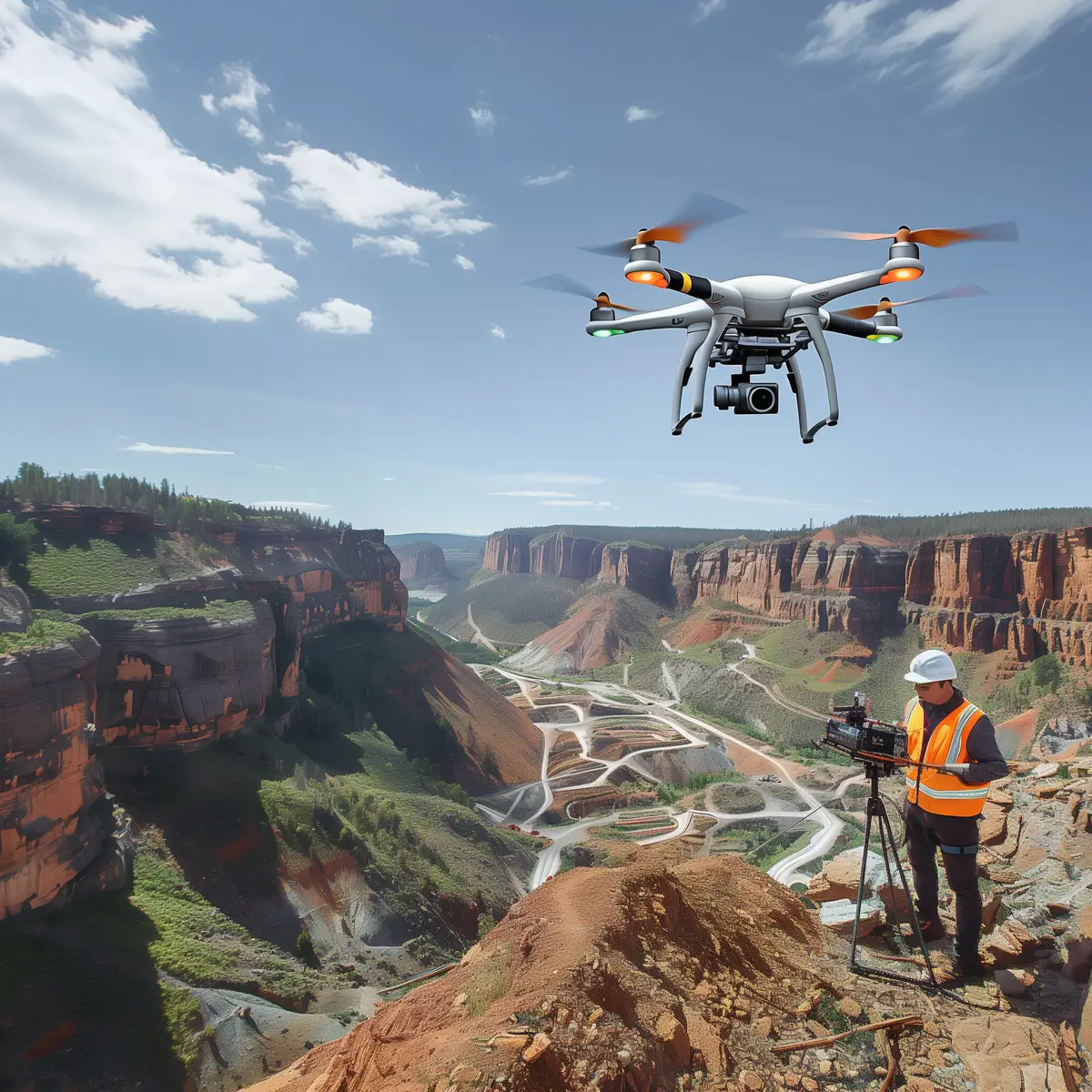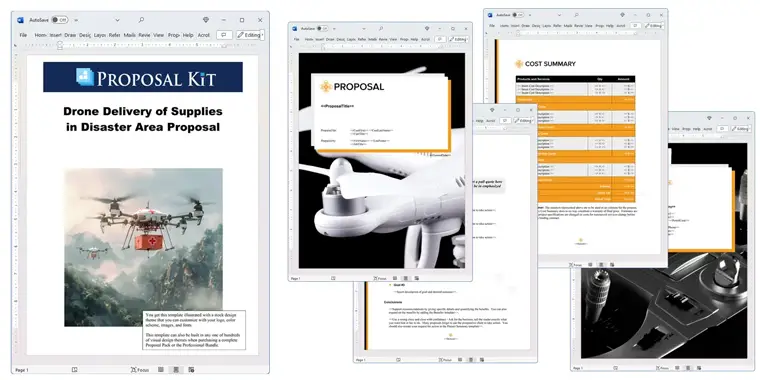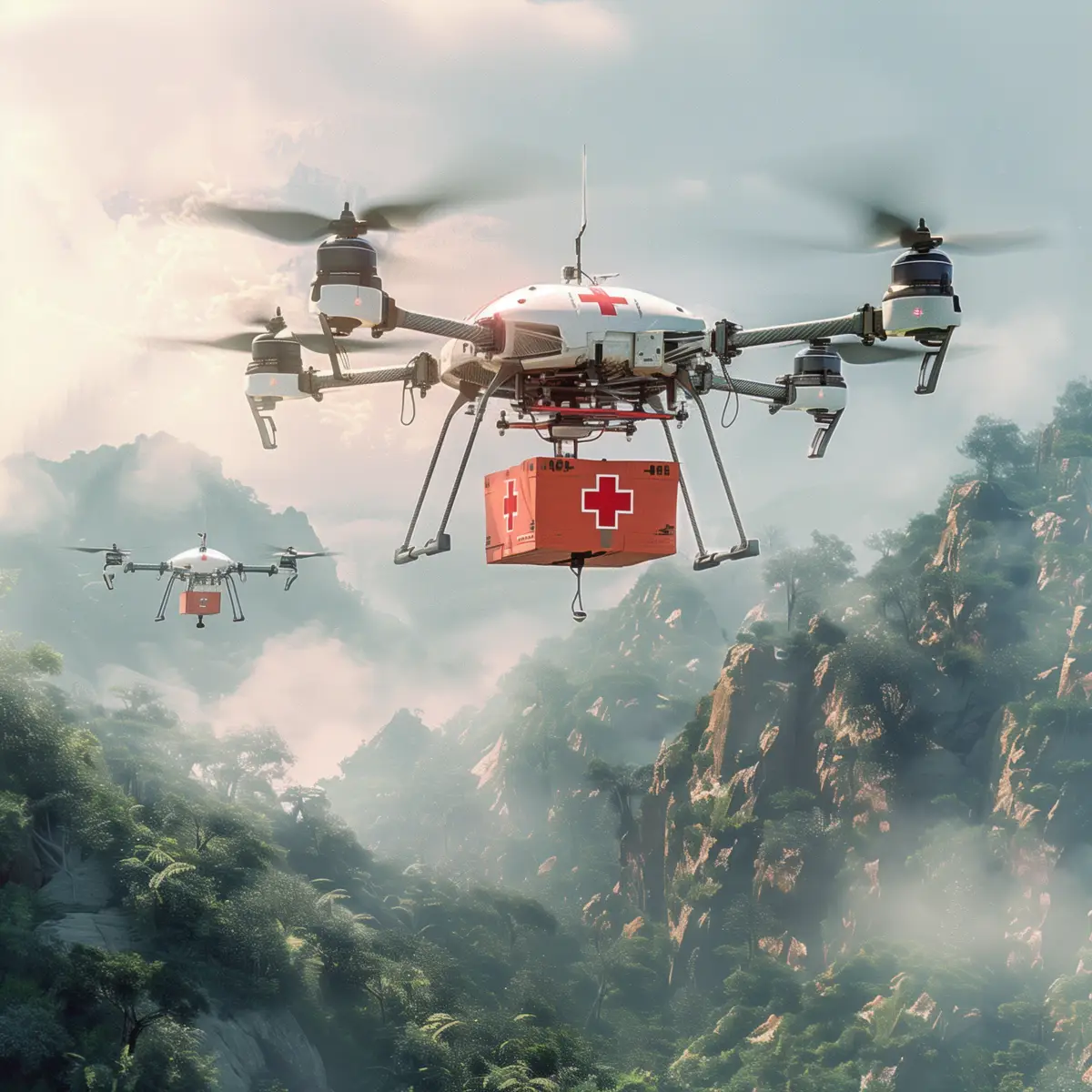How to write your Drone Delivery of Supplies in Disaster Area Proposal
We include this 19 page layout with every Proposal Pack. If you want this template to have a different visual design theme than the one illustrated here, purchase any Proposal Pack design and create this template using the purchased design theme. This template is included in every Proposal Pack. If you get a Proposal Pack or the Professional Bundle, you can also make any variation of this template with different chapters to suit your needs.
We typically include more chapters in the templates than most people will need to give everyone more variety in the chapters they may need. You can trim down a long template by removing pages you do not need or combining multiple chapter topics into one page.
 DOWNLOADABLE, ONE-TIME COST, NO SUBSCRIPTION FEES
DOWNLOADABLE, ONE-TIME COST, NO SUBSCRIPTION FEES![]() View Drone Delivery in Disaster Area Sample Proposal
View Drone Delivery in Disaster Area Sample Proposal
This sample proposal is based on the same layout as this template and is included in every Proposal Pack. The visual design of the templates will match whichever Proposal Pack design you purchase. To get this template in a different design theme than shown in the sample, purchase any other Proposal Pack design theme and this template will be included.
You can create an editable Word version of this sample in any design theme of your choice including branded to your logo.
 If you need this template on DVD media order from our Amazon shop.
If you need this template on DVD media order from our Amazon shop.
You can also create countless variations of this document to suit your needs using the included library of 2200+ chapters if ordering a Proposal Pack or Pro Bundle.
 What Our Clients Say
What Our Clients SayFor those in the proposal writing business or proposal writing is part of your business this is one of the most comprehensive and cost effective systems out there. Every step is covered and it’s like someone is there taking you by the hand and walking you through the process to success. I love it (and my WIFE likes it too)."
The Authentic Leadership Institute
Related Article
Related Video
Related Templates
- Drone Mapping and Survey Services Proposal
- Software Automation Proposal
- Industrial Automation Proposal
- Autonomous Vehicle Regulations Proposal
- Robotics Automation Project Proposal
- Artificial Intelligence Project Funding Proposal
- Humanitarian Aid Services Support Proposal
- Stockpiling Emergency Supplies Proposal
- Disaster Relief and Recovery Proposal
- Disaster Preparation and Training Proposal
- Disaster Cleanup Services
- Food Aid Grant Project Proposal
- EMS Onsite Services Proposal
- Medical Equipment Supply and Transportation Proposal
What's the Best Way to Write Your Drone Delivery of Supplies in Disaster Area Proposal?
A proven way to create a drone delivery of supplies in a disaster area proposal is by using the Proposal Kit template and software package. This comprehensive tool simplifies the proposal writing process for those unfamiliar with the intricacies of proposal documentation. Proposal Kit's template library and Wizard software program offer a structured approach, complete with a line item quoting database system for detailed cost summaries, quotes, estimates, budgets, and other financial details, ensuring your proposal is professional and persuasive.
What Types of Projects Are Drone Delivery of Supplies in Disaster Area Proposals Written For?
Drone technology is increasingly in disaster response efforts, providing quick, safe, and efficient delivery of supplies. Here are ten project types where drones can make a significant impact:
- Delivering medical supplies to inaccessible regions.
- Transporting food and water during floods or earthquakes.
- Providing communication devices to cut-off areas.
- Dropping emergency shelters and blankets in cold weather disasters.
- Sending batteries and power supplies where electricity is out.
- Delivering first aid kits to sites of natural disasters.
- Transporting fire extinguishers and safety equipment in fire outbreaks.
- Dropping life vests and rescue ropes during floods.
- Providing reconnaissance photos and videos for mapping disaster impacts.
- Transporting search and rescue equipment during emergencies.
Chapters this template is built with
If you need to propose a drone delivery service for disaster relief, consider how critical such proposals are. A comprehensive proposal will include many topics; here is a list of chapters used for one such proposal.
These chapters are just a selection from the thousands available in Proposal Kit's library, which allows extensive customization to suit any proposal need.
Cover Letter
The cover letter introduces the proposal and your organization, paving the way for the following detailed documentation. It should capture the essence of your mission and briefly outline the proposal's purpose. Use this opportunity to make a solid first impression by demonstrating professionalism and commitment to the cause, setting a confident tone for the rest of the document.
Executive Summary
The executive summary addresses the urgent need for drone delivery services in disaster-hit areas. It should briefly summarize these challenges and how your drone delivery solution can address them effectively. Highlight the quick deployment capabilities, the reduction of risk to human life, and the ability to reach inaccessible areas, making a solid case for adopting your proposal.
Cost Summary
Detail all expected costs associated with deploying and operating drone delivery services using Proposal Kit's line item quoting features. This includes the cost of acquiring drones, maintenance, operational expenses, and any staff training required. Ensuring clarity and precision in this section helps stakeholders understand the financial requirements and demonstrates your careful planning and transparency.
Benefits
Describe the direct benefits of drone delivery, such as the speed of delivery that surpasses traditional methods, the safety of operations without risking human lives, and the ability to access hard-to-reach areas quickly. This enhancement of the proposal's appeal should align with the interests of potential funders or partners, showing the tangible impacts of drone technology in disaster relief efforts.
Remote Control
Describe the technology used to control the drones remotely, emphasizing its reliability and ease of use. Include information on the control systems, range, user interface, and fail-safes that ensure the drones can be operated even in challenging conditions. This section reassures the reader of your technology's capability to perform under pressure.
Disaster Relief
Highlight how your drone service specifically addresses the unique needs of disaster relief efforts, such as rapid damage assessment, delivery of important supplies, and support in evacuation procedures if needed. Discuss how drones can enhance the overall efficiency of response efforts and support existing disaster management frameworks.
Response Time
Discuss your drones' quick deployment capabilities, an important factor in emergency situations where every second counts. Explain how the drones can be launched immediately upon disaster notification and the speed at which they can reach affected areas.
Payload
Specify the types and weights of supplies your drones are equipped to carry, demonstrating the versatility of your service. Include examples such as medical supplies, food packets, and other emergency items, showcasing the ability to adapt payloads based on specific disaster needs.
Supplies
List the kinds of supplies that your drones can transport, tailored to various disaster scenarios. This may include first aid kits, water purification tablets, emergency food rations, and more. Each item should reflect a thoughtful response to the requirements of disaster-hit areas.
Equipment
Detail the specific drone equipment and any auxiliary tools used in operations. Discuss the drones' durability and capabilities and any additional equipment, such as payload delivery mechanisms or cameras for aerial surveillance.
Hardware and Software
Outline the technological components of the drones, including hardware robustness and any software that enhances functionality, such as GPS for precise location tracking, automated flight paths, or real-time data transmission systems that contribute to effective mission management.
Emergencies
Explain the procedures for handling emergencies during drone operations, ensuring safety and compliance. This should cover emergency landing protocols, communication breakdowns, and contingency plans for unexpected scenarios.
Specifications
Provide detailed specifications of the drones, such as flight endurance, range, altitude capabilities, and weather resilience, to underline their suitability for the tasks expected in disaster response operations.
Cost Savings
Illustrate how using drones reduces costs compared to traditional delivery methods. Highlight savings on human resources, reduced time in reaching affected areas, and lower risk of damage or loss of life, thereby enhancing the cost-effectiveness of disaster response efforts.
About Us
Share information about your organization, including its history, mission, and previous involvement in disaster relief efforts. Building credibility and trust through transparency about your expertise and dedication to humanitarian aid can strengthen the proposal's impact.
Distribution
Describe how the drones will be distributed and managed during disaster relief operations. Include logistical details such as deployment strategies, operating bases, and coordination with local authorities to ensure an organized and effective response.
Use cases for this template
Mission-Critical Proposal
Mara, the owner of SkyAid Tech, faced the challenge of launching a new drone technology to enhance disaster response capabilities. Recognizing the critical nature of rapid and reliable disaster relief, Mara sought to secure funding and partnership through a well-constructed proposal.
Using Proposal Kit, she wrote a document that demonstrated the technical prowess of her drones and emphasized their practical application in real-world disaster scenarios. Her proposal detailed how drones could navigate challenging terrains to deliver medical supplies quickly without the complications associated with traditional delivery methods.
Mara's proposal included visual aids and technical specifications pulled from Proposal Kit's extensive database, enhancing her narrative with concrete data and projections. This comprehensive approach allowed potential funders and partners to grasp the transformative impact of her technology, leading to successful funding rounds and the establishment of critical partnerships for field trials.
Just-in-Time Delivery
Jake, an operations manager at RapidResponse Tech, was in a high-stakes situation with a deadline for a government disaster relief contract. The proposal required detailed technical specifications, operational plans, and a thorough cost analysis within a tight timeframe.
Turning to the Proposal Kit, Jake found a structured framework that streamlined the proposal development process. He leveraged the software to organize the necessary data, including the drones' cost breakdowns and technical capabilities, into a clear, compelling format. Additionally, Jake used an AI writing tool to enhance the content of specific sections, such as the executive summary and the technical descriptions.
This integration of technology allowed him to enrich his proposal while adhering to the strict deadline. The result was a drafted proposal that met all governmental requirements and showcased RapidResponse Tech's readiness and capability to manage disaster relief efforts effectively.
Leadership in Non-Profit
Lila, the director at HelpFromAbove, recognized the need for more advanced drone technology to bolster their disaster relief operations. Tasked with drafting a Request for Proposals (RFP) to procure these drones, Lila faced the challenge of ensuring clarity and precision to attract the right vendors.
She constructed a detailed RFP outlining specific technical requirements, performance benchmarks, and partnership expectations using the Proposal Kit. The templates provided by the Proposal Kit helped her articulate the scope of supply, operational criteria, and evaluation metrics, facilitating a straightforward and efficient vendor assessment process.
This transparent, structured approach attracted responses from top-tier drone suppliers and streamlined the decision-making process, enabling HelpFromAbove to enhance its operational capacity with the best available technology.
Conclusions and Recommendations
Writing a drone delivery of supplies in disaster area proposal can be streamlined and made more effective with the help of the Proposal Kit.
It simplifies the documentation process, ensures all necessary details are covered, and effectively conveys the urgency and importance of the project. Using the Proposal Kit not only aids in creating compelling proposals but also enhances the overall presentation, ensuring that your project stands out.
Also Known As
This template may also be referred to in different ways or be used in more specialized situations, such as:
- Disaster Relief Drone Delivery Proposal
- Emergency Supply Drone Deployment Plan
- Aerial Supply Delivery Project Proposal
- Humanitarian Aid Drone Delivery Proposal
- Crisis Response Drone Logistics Proposal
- Drone-Assisted Disaster Relief Plan
- UAV Supply Distribution Proposal for Disaster Areas
- Aerial Logistics Support Proposal for Emergencies
- Drone-Based Emergency Supply Proposal
- Disaster Area Aerial Delivery System Proposal
Abstract
 In the aftermath of natural disasters, the need for effective delivery of lifesaving supplies becomes paramount. Disaster response teams increasingly turn to unmanned aerial vehicles (UAVs), commonly known as drones, to deliver critical supplies to affected populations. These delivery drones are used by rescue teams to transport important supplies, such as medical aid, food, and medications, to remote areas where traditional vehicles struggle to reach. Using drones for disaster situations allows for quick assessment of damage, even in the presence of collapsed buildings or flooding. Equipped with high-resolution cameras and advanced sensors, drones can efficiently identify the extent of damage and help ground teams determine where assistance is most needed.
In the aftermath of natural disasters, the need for effective delivery of lifesaving supplies becomes paramount. Disaster response teams increasingly turn to unmanned aerial vehicles (UAVs), commonly known as drones, to deliver critical supplies to affected populations. These delivery drones are used by rescue teams to transport important supplies, such as medical aid, food, and medications, to remote areas where traditional vehicles struggle to reach. Using drones for disaster situations allows for quick assessment of damage, even in the presence of collapsed buildings or flooding. Equipped with high-resolution cameras and advanced sensors, drones can efficiently identify the extent of damage and help ground teams determine where assistance is most needed.
Drones, as an energy-efficient technology, offer a cost-effective solution for delivering packages safely in harsh weather conditions and rural areas. Their ability to navigate without relying on satellite signals or the naked eye makes them invaluable during recovery efforts. This technology can save lives by delivering vaccines and critical medicines to health facilities and clinics in cut-off communities. The integration of drones into disaster relief extends beyond just delivering supplies; they play an important role in environmental monitoring, quickly surveying dangerous areas from the air.
As we explore the future of drone technology in disaster relief, it's evident that drones can make a significant difference in the world. Their presence in the skies provides a lifeline to victims and residents, helping communities regain stability after a crisis. By testing and expanding their use, we can improve the efficiency of disaster response, ultimately making it possible to respond more and ensure faster recovery.
 In disaster situations, where traditional transportation methods face significant limitations, the implementation of unmanned aerial vehicles offers a revolutionary approach to delivering lifesaving supplies. Disaster response teams are increasingly relying on electric drones due to their ability to deliver medications, including blood and vaccines, swiftly and efficiently. These drones reduce reliance on helicopters and traditional vehicles, which are often hindered by debris from collapsed buildings or washed-out bridges. By flying over these obstacles, drones can quickly reach victims in remote and inaccessible areas, ensuring that relief materials are delivered promptly.
In disaster situations, where traditional transportation methods face significant limitations, the implementation of unmanned aerial vehicles offers a revolutionary approach to delivering lifesaving supplies. Disaster response teams are increasingly relying on electric drones due to their ability to deliver medications, including blood and vaccines, swiftly and efficiently. These drones reduce reliance on helicopters and traditional vehicles, which are often hindered by debris from collapsed buildings or washed-out bridges. By flying over these obstacles, drones can quickly reach victims in remote and inaccessible areas, ensuring that relief materials are delivered promptly.
Drone technology, characterized by its cost-effective and energy-efficient nature, allows response teams to maintain ongoing operations without the high expenses typically associated with traditional logistic methods. Equipped with high-resolution cameras and advanced sensors, drones provide important reconnaissance capabilities, enabling ground teams to assess the situation and plan repairs to critical infrastructure. In addition, drones can conduct environmental monitoring, assisting firefighters and other emergency personnel in identifying hazards such as fires or chemical spills. This capability is crucial in determining the safety of affected areas and guiding rescue teams to the most critical locations.
Moreover, the integration of drones into disaster relief operations involves the coordination of satellite signals and remote control systems, ensuring that these unmanned aerial vehicles can be flown safely even under challenging weather conditions. This flexibility is particularly important in rural areas where limited infrastructure and difficult terrain can impede traditional rescue efforts. By using drones, response teams can deliver food, water, and medical supplies directly to communities in dire need, ultimately enhancing the overall effectiveness of disaster response initiatives.
 As we look to the future, the role of drones in disaster situations is poised to expand further. Continued testing and improvements in drone technology will enable these devices to maneuver more precisely and autonomously, reducing the risk of crash-related incidents. The use of drones as part of a comprehensive disaster relief strategy will not only improve response times but also allow for better resource allocation, ensuring that assistance reaches those who need it most quickly and efficiently. By exploring new applications and capabilities, drones can become an indispensable tool in global humanitarian efforts, helping to save lives and rebuild communities in the wake of natural and man-made disasters.
As we look to the future, the role of drones in disaster situations is poised to expand further. Continued testing and improvements in drone technology will enable these devices to maneuver more precisely and autonomously, reducing the risk of crash-related incidents. The use of drones as part of a comprehensive disaster relief strategy will not only improve response times but also allow for better resource allocation, ensuring that assistance reaches those who need it most quickly and efficiently. By exploring new applications and capabilities, drones can become an indispensable tool in global humanitarian efforts, helping to save lives and rebuild communities in the wake of natural and man-made disasters.
Frequently Asked Questions
What should be included in a proposal for drone delivery of supplies in a disaster area?
Include an introduction, project objectives, scope of work, technical specifications of the drones, logistics and operational plan, risk assessment, timeline, budget, and expected outcomes.
How do I address drone delivery's logistical challenges and feasibility in disaster areas?
Detail the drone's capabilities, range, payload capacity, and ability to navigate challenging environments. Include a plan for coordinating with local authorities and managing airspace regulations.
What considerations should be made for the safety and reliability of drone operations in disaster zones?
Include a risk assessment that addresses potential hazards, contingency plans, drone maintenance schedules, pilot training requirements, and strategies for ensuring supplies' safe and reliable delivery.
How can I demonstrate drone delivery's potential impact and effectiveness in disaster areas?
Provide case studies or examples of successful drone deliveries in similar scenarios, include data on time saved and lives impacted, and highlight the advantages of using drones over traditional delivery methods in disaster relief.
What is the best way to present the budget and cost-effectiveness of the drone delivery project?
Provide a detailed budget breakdown, including costs for drones, personnel, logistics, maintenance, and training. Justify each cost by explaining its necessity and demonstrate the overall cost-effectiveness compared to other delivery methods.
15% Off Discount
![]() Add To Cart This Word Template Only
Add To Cart This Word Template Only
 Add To Cart Proposal Pack Tech #9
Add To Cart Proposal Pack Tech #9
 Add To Cart Proposal Kit Professional Bundle
Add To Cart Proposal Kit Professional Bundle
 4.7 stars, based on 846 reviews
4.7 stars, based on 846 reviewsProposal Kit chapters used in this template
Cover Letter, Title Page, Table of Contents, Executive Summary, Emergencies, Disaster Relief, Supplies, Distribution, Response Time, Benefits, Remote Control, Hardware and Software, Cost Summary, Equipment, Payload, Cost Savings, About Us, Specifications, Back Page
Included Calculator Spreadheets
These Excel calculator spreadsheets are included with this template. If you purchase a Proposal Pack or the Professional Bundle, these proposal pages are generated using an automated line-item database in the included Wizard software. The calculator spreadsheets are intended for use when purchasing only the static Word template.
You use this proposal for
- General business proposal
- Technical proposal
- Project pitch proposal
- Medical, healthcare, wellness proposal
- IT, software, hardware proposal
- Security, safety, protection, investigation proposal
- Military proposal
- Aerospace proposal
How to create this template with Proposal Pack Wizard
You can create this document using any of the logo-designed Proposal Packs. Pick any Proposal Pack with a logo design theme you like best; they will all work equally well. The Proposal Pack for Any Business is the pack with no extra added logos or colors - designed to be used plain or for you to customize with your logos and graphics.
The Proposal Pack design theme you purchase will determine the visual look of this template. The screenshot above only shows the plain generic design theme. Names and stories in examples are fictional; however, the templates are from real client use cases.
We include a library of chapters to be assembled based on your needs. All proposals are different and have different needs and goals. We designed Proposal Pack so you can customize the documents to suit your needs.
You will best create this document using the Proposal Pack Wizard - Expert Edition software to select this template and build it in the Proposal Pack logo design theme of your choice along with any desired customizations (such as adding additional chapters, removing unneeded chapters, changing the order of chapters, and importing your company logo). This template outlines a proposal for the described situation. Each user is responsible for typing in the actual content of the provided pages with their information to complete the proposal. Suggestions in the abstract may include features in higher-end packages and are facilitated by the selection of chapter templates to support the narrative of each proposal, which help guide the user in filling in the details.
You create this template using the Wizard software with an entire Proposal Pack library and software. We include the Expert Edition of the software in the Proposal Kit Professional bundle. Microsoft Word for Windows is required to use the customizing software. You can also edit Word document templates in other office software such as Word for Mac. We will assist Mac users in assembling complex templates for their first project if they do not have the required platform to run the Wizard software.
You only get the single assembled Word document if purchased as a stand-alone template. The individual template products include no other templates, samples, or software.
How to Build Templates Featured on Proposal Kit Website
Many people find the Proposal Kit website after searching for a specific proposal. Once you've purchased and installed the software, how do you build that template you found in the first place? This video shows you how to build any proposal you see on the Proposal Kit website.
Key Takeaways
- The Drone Delivery of Supplies in Disaster Area Proposal is available as a ready-to-edit template.
- You can create unlimited custom variations of this template using a Proposal Pack or the Professional Bundle.
- Using a Proposal Pack or Professional Bundle, you can automate quotes and other financial pages with a line-item database.
- There are no ongoing subscription fees. You get lifetime unlimited use.
- We made Proposal Kit for freelancers, small businesses, and non-profits.
- Proposal Kit product content (templates, samples, software) is 100% written by humans.
 Ian Lauder has been helping businesses write their proposals and contracts for two decades. Ian is the owner and founder of Proposal Kit, one of the original sources of business proposal and contract software products started in 1997.
Ian Lauder has been helping businesses write their proposals and contracts for two decades. Ian is the owner and founder of Proposal Kit, one of the original sources of business proposal and contract software products started in 1997.By Ian Lauder
 Published by Proposal Kit, Inc.
Published by Proposal Kit, Inc.


 Cart
Cart


 Get 15% off ordering today:
Get 15% off ordering today: 

 Facebook
Facebook YouTube
YouTube X
X Search Site
Search Site